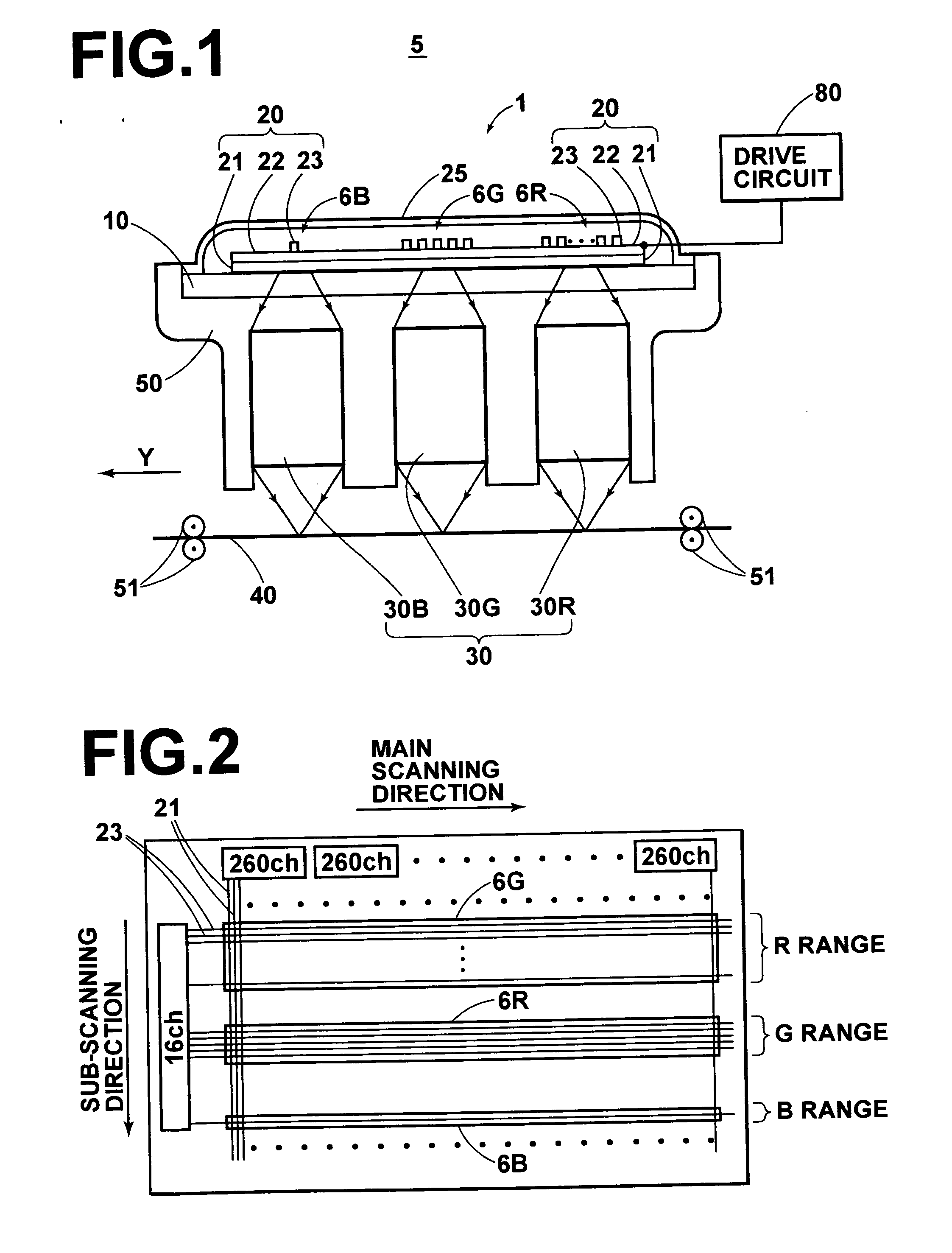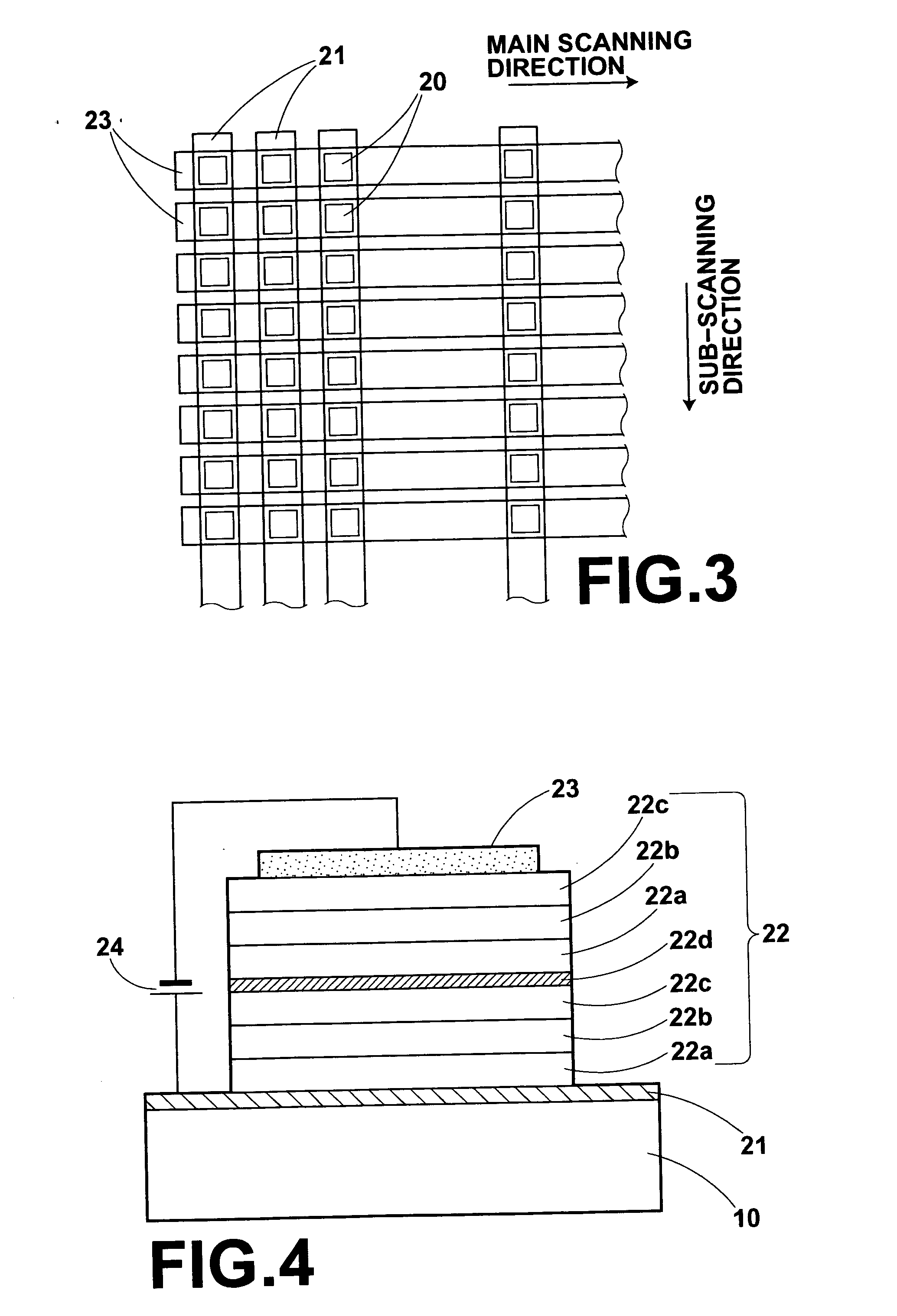Exposure system
- Summary
- Abstract
- Description
- Claims
- Application Information
AI Technical Summary
Benefits of technology
Problems solved by technology
Method used
Image
Examples
first embodiment
[0023] As shown in FIG. 1, an exposure system 5 in accordance with a first embodiment of the present invention has an exposure head 1. The exposure head 1 comprises a transparent base 10, a red emitting element array 6R, a green emitting element array 6G and blue emitting element arrays 6B formed of number of organic EL elements 20 formed on the base 10 by deposition, refractive index profile type lens arrays 30 (30R, 30G and 30B) which are a unit system for imaging on a color photosensitive material 40 an image generated by the light emitted from the organic EL elements 20, and a support 50 which supports the base 10 and the refractive index profile type lens arrays 30.
[0024] The exposure system 5 further comprises, in addition to the exposure head 1, a sub-scanning means 51 in the form of, for instance, a pair of nip rollers which conveys the color photosensitive material 40 at a constant speed in a direction of arrow Y.
[0025] The organic EL elements 20 comprises an organic comp...
second embodiment
[0056] An exposure system in accordance with a second embodiment of the present invention will be described, hereinbelow. The second embodiment is basically the same as the first embodiment except that the light emitting size of the organic EL element 20B differs from that in the first embodiment. That is, in this embodiment, the organic EL elements 20R, the organic EL elements 20G, and the organic EL elements 20B are all 40×40 μm in light emitting size. Accordingly, the light emitting areas Sr, Sg and Sb are as follows.
Sr=1600 μm2
Sg=1600 μm2
Sb=1600 μm2
[0057] The values of M×N×τ×S for the respective colors are as follows.
Mr×Nr×τr×Sr=9600000 (h·μm2)
Mg×Ng×τg×Sg=9600000 (h·μm2)
Mb×Nb×τb×Sb=10240000 (h·μm2)
[0058] Though the value of Mb×Nb×τb×Sb differs from the value of Mr×Nr×τr×Sr or Mg×Ng×τg×Sg, such a small difference is able to prevent color balance in the exposed image from being largely shifted. Generally, when the ratio of the values of M×N×τ×S of the colors is in about 1:2, it is...
third embodiment
[0061] An exposure system in accordance with a third embodiment of the present invention will be described, hereinbelow. The third embodiment is basically the same as the first embodiment except that the values of M, N, τ and S differ from those in the first embodiment.
[0062] The values in the third embodiment are shown in the following table 3.
TABLE 3MNτ (h)S (μm2)M × N ×τ× S (h ·μm2)R51210016009600000G10320016009600000B11320030009600000
[0063] In this embodiment, since the values of M×N×τ×S for the respective colors are the same as in the first embodiment, it is possible to strictly prevent color balance in the exposed image from being shifted.
PUM
 Login to View More
Login to View More Abstract
Description
Claims
Application Information
 Login to View More
Login to View More - R&D
- Intellectual Property
- Life Sciences
- Materials
- Tech Scout
- Unparalleled Data Quality
- Higher Quality Content
- 60% Fewer Hallucinations
Browse by: Latest US Patents, China's latest patents, Technical Efficacy Thesaurus, Application Domain, Technology Topic, Popular Technical Reports.
© 2025 PatSnap. All rights reserved.Legal|Privacy policy|Modern Slavery Act Transparency Statement|Sitemap|About US| Contact US: help@patsnap.com



